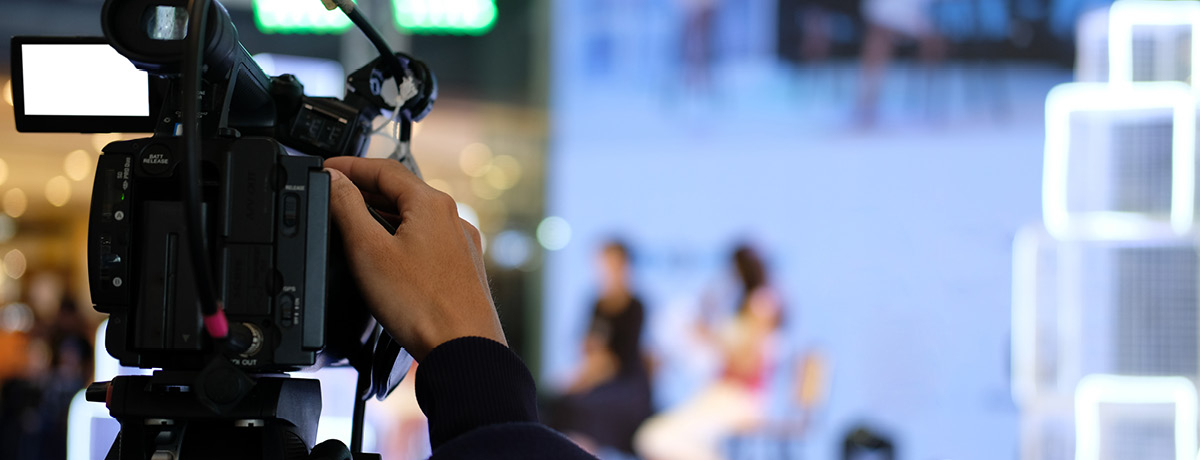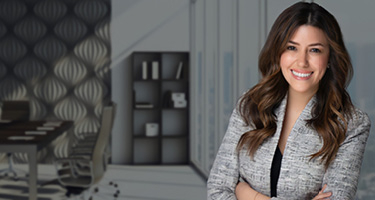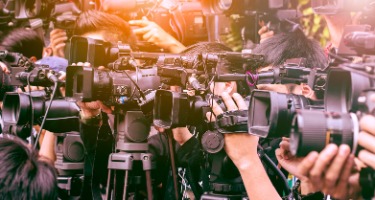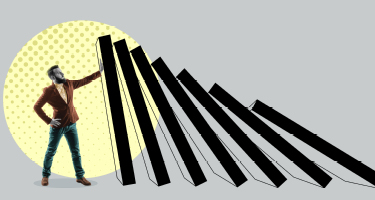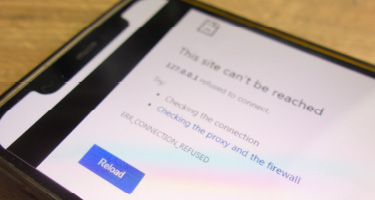Now that courtrooms in the United States have reopened, the world has regained front-row seats to the drama of high-profile cases—from Johnny Depp’s defamation trial to the sentencing of Ahmaud Amery’s killers.
The lawyers who appear in court often receive attention from the public and social media that they might not have expected, particularly in matters that drive national policy and cultural dialogue. Lawyers becoming part of the story is not new, but the scenario is happening more frequently because there are more ways to observe and voice an opinion. For example, a news commentator might analyze the effectiveness of a lawyer’s argument, while a social media influencer might quip about the same practitioner’s mannerisms or wardrobe choices and receive countless likes and shares—thus redirecting the focus.
Lawyers in various practice areas and stages in their careers shared with Best Lawyers their experiences in the spotlight, perspectives on this new norm of intensified accessibility as well as traditional and social media attention and how all of it has impacted their own careers and how it might also shape the profession.
Media Strategy and Engagement
Timothy A. Loranger is an attorney and senior shareholder at the national mass disaster law firm of Baum, Hedlund, Aristei & Goldman in California. A pilot and Marine Corp Veteran, Loranger has a particular focus on transportation and aviation law, and media engagement can be a default responsibility of his work, especially when catastrophe and tragedy strike.
“There are cases that you know will be followed and you need to get out in front of it in order to put the emphasis on your clients,” said Loranger, who was recognized in The Best Lawyers in America® as a 2020 “Lawyer of the Year” for Personal Injury Litigation – Plaintiffs in Los Angeles.
For example, in January 2013 a private plane crashed into a Palm Coast home in Florida, killing all three people aboard. In 2015, Loranger filed a wrongful death suit on behalf of the estate of one of the passengers against the United States of America, as the air traffic controllers directing the aircraft on the day of the crash were employees of The Federal Aviation Administration (FAA), an agency of the United States Department of Transportation.
Loranger claimed in the suit that the air traffic controllers could have done more to keep the pilot and plane from crashing into the house.
“This was an important case because it put a spotlight on one of the weaknesses of the FAA,” Loranger said. “The message through the media had to be broad and really have relevance to a larger audience. You have to tap into that and not just put your own name out there.”
Though he said he was not entirely comfortable with media and interviews early on in his career, Loranger took a cue from others at his firm, like former shareholder Ronald L. M. Goldman, who is now of counsel to Baum Hedlund and also recognized in The Best Lawyers in America for Aviation Law, Plaintiffs Personal Injury and Products Liability. Goldman has practiced law for nearly 60 years, led major tort litigations and has appeared in the media more than 2,000 times concerning aviation accidents and pharmaceutical drug product liability, including safety oversight issues.
“Seeing how Ron conducts himself in the media has taught me a tremendous amount,” Loranger said. “If we don’t go to some formal media training classes, we learn from our mentors how to best interact with the media. Now I am thankfully in a position to pass on that knowledge to some of the younger and new lawyers at the firm.”
In the Crosshairs
Media engagement might be one of a lawyer’s unofficial responsibilities or even a perk. But becoming part of the story out of the courtroom is another matter, as Christopher M. Mattei of Koskoff Koskoff & Bieder can attest.
A former Assistant United States Attorney and a one-time nominee for Connecticut Attorney General, Mattei had been on the periphery of media attention for some notable criminal prosecutions—such as serving as trial counsel in the prosecution of former Governor John G. Rowland and others on campaign finance and obstruction of justice charges.
Mattei was also a key member of the Koskoff team representing families of victims of the 2012 Sandy Hook Elementary School mass shooting who filed a defamation suit in Connecticut against Infowars founder and conspiracy theorist Alex Jones. The suit was predicated on his false claims that the tragedy, in which 20 children and six adults died, was staged. Adding to the drama surrounding the suit, Jones later announced on his show a $1 million bounty for Mattei’s “head on a pike,” and suddenly the lawyer was thrust into the spotlight and the target of a hostile audience.
“[Jones] had done similar things in the past and we knew it could have real-life consequences,” said Mattei, who has been recognized in The Best Lawyers in America for Personal Injury Litigation – Plaintiffs since 2020. “So, it was concerning my family a bit, as well as the folks in our firm and people like our staff and secretaries and receptionists who aren’t used to being at the center of controversy. It was very upsetting and disturbing.”
Jones’ statement caused him to be sanctioned by the court. He lost his special motion to dismiss, which he appealed to the Connecticut Supreme Court and also lost.
While Mattei would have preferred not to have such negative and potentially dangerous attention, he said the experience helped him better empathize with his clients, who had endured unnecessary trauma from Jones’ audience in the aftermath of the tragedy.
“In the long run, it gave me a small sense of what it has been like for the families that we represent,” Mattei said. “They had been attacked online and those attacks translated into offline encounters and harassment. In that sense, I felt like I was in the trenches with them.
If you’ve got integrity, then you don’t really have to worry about people picking apart the work you are doing. This may not work for everybody, but I try to be the same person in the courtroom as I am outside the courtroom.”
Trending Now
The court of public opinion is shaped by every platform—from print coverage to memes on a phone.
Brown Rudnick Partner Camille M. Vasquez was thrust into the spotlight during the Johnny Depp v. Amber Heard defamation trial in Spring 2022. Vasquez’s career was already on the rise, having been voted into the inaugural edition of Best Lawyers: Ones to Watch in America™ in 2021 and again for 2022 and 2023.
But by the time the young lawyer was delivering half of Depp’s closing argument in May 2022, her name became a trending Twitter search and was showcased in headlines across the globe. On June 1, it was announced that the jury had found both Depp and Heard were liable for defamation, though it was a bigger win for Depp. Shortly afterward, Vasquez was promoted from associate to firm partner for her integral role in the result. And by July, she was being interviewed by Gayle King on CBS Morning News, further exposing her to a national audience.
When Best Lawyers CEO Phillip Greer asked whether she’d advise other professionals to use or avoid the media attention, Vasquez replied with cautious enthusiasm.
“I think that you can absolutely utilize it,” she told Best Lawyers in an interview shortly after the verdict was announced in June 2022. “It’s just another tool in our tool shed that we should use. It’s important to be cautious of how you utilize it, but it’s absolutely, I think, a benefit to be represented by lawyers that people know and respect or because the client is high profile, or the case is high profile, because it touches on things that are happening in the world or in society. Litigation is about messaging. Whether it’s to the court or to the jury or to the public. It’s about messaging and how you advocate for your clients and for the general message that the case is bringing to light.”
Vasquez’s attention on social media in itself demonstrated the reach of global digital culture—whether someone commented on her photos with hashtags like “standing with” Depp or Heard, millions of Facebook, Instagram and Twitter users had an opinion.
Siri Nelson, a practicing lawyer and the executive director of the National Whistleblower Center (NWC) understands the intensified attention that comes with being visible in a matter of national or public interest. Many of her NWC colleagues and their clients are put in the public eye when they testify in courts and hearings against powerful and well-funded entities and governmental organizations. Nelson said the scrutiny from traditional and social media can add to the noise and drive the dialogue into unrelated off-roads.
She noted that the focus Vasquez attracted beyond her professional abilities—from comments about the young lawyer’s appearance and a repurposed screenshot of her laughing with her client to diametrically opposed hashtags like #GirlbossLawyer and #MeanGirl—exemplify the continued disparity between men and women in the profession.
“An important part of being a woman in the profession is that the intense attention that you will receive, unfortunately, has a lot to do with how you’re perceived by men and how men perceive women,” Nelson said. “In a highly visual realm like social media, and media in general, that becomes a major issue.”
Nelson noted that this dynamic can have a broader impact on women as they build their resumes.
“If there’s a woman who’s not that interested in getting that visual attention, she might back away from certain or really important cases because she doesn’t want that media attention,” Nelson said. “But it’s going to hurt her career, because you need to have those important cases in your professional history to advance as an attorney.”
A digital and social media profile can be useful or detrimental, noted Andy Blum of AJB Communications, who specializes in media training and public relations for lawyers, firms and other professionals.
“Social media presence is important for lawyers today but it’s not the only thing,” Blum said. “A savvy marketing department should work with the lawyer, the PR person and the social media staff to get a mix of news media clips, social media posts and marketing content out to raise his or her profile.”
He added that when public attention dominates a case, it can benefit the profession, but not exclusively.
“[Attention outside the courtroom] is shaping the profession for the better, but there is still a fine line sometimes,” Blum said. “Either too much or too little, and a reticence on the part of some to talk out of the courtroom, makes it a work in progress. It still comes down to what is best for the firm and best for the clients. And it takes time for the work in progress to get to the next level.”
Recommendations Based on Previous Viewing
But the public and media interest in trials is not relegated solely to current events. The COVID-19 pandemic further expanded the at-home viewing market, and news outlets and streaming services tapped into the curiosities of their newer and captive audiences. Gone are the days of waiting to tune in to weekly legal dramas from major networks—we can count on a new in-depth docuseries or feature about a famous crime or nearly-forgotten court case regularly, from one of countless on-demand platforms.
Loranger referred to the documentary “Hot Coffee” as a great example of how media and its availability on streaming services can be used to strengthen the profession. Released in 2011, “Hot Coffee” analyzed the impact of tort reform on the U.S. judicial system. Its catalyst was the Liebeck v. McDonald’s Restaurants lawsuit, in which the 79-year-old plaintiff was severely burned after spilling into her lap hot coffee purchased from a McDonald’s. The jury awarded Stella Liebeck $2.9 million in 1994, and though some at the time considered it a frivolous lawsuit and little more than a punchline on “Seinfeld,” the film demonstrated the extent of the injury and how the award was allocated.
“Lawyers have had a bad rap for a long time, [portrayed] as money-hungry people who didn’t really care about their clients,” Loranger said. “But ‘Hot Coffee’ really showed the truth about how [Liebeck] was very badly injured and it showed her third-degree burns and skin grafts. People were shocked that this was not millions of dollars awarded to somebody whose pants got wet due to a little warm water. This allowed people to see through the corporate messaging, and I think that there’s a lot of good that can come from these documentaries. They show a different side of the legal practice and our justice system and provide a better view, instead of just [playing] sound bites.”
“Hot Coffee” was nominated for the Sundance Film Festival’s Grand Jury Prize in 2011 and, like many other substantive documentaries, now makes its rounds beyond the DVD rack and libraries through streaming services like Netflix.
Fascination with real events and true crime continues to permeate mainstream culture as well. For example, the 2018 “Waco” mini-series was a portrayal of the FBI and ATF seizing of religious leader David Koresh’s Branch Davidian compound near Waco, Texas in the spring of 1993. Its follow-up, “American Tragedies: Waco – The Trials” is slated for 2023 on the Paramount Network and has much of the original cast, including Michael Shannon and John Leguizamo, returning.
One notable new cast member will be Giovanni Ribisi, who will portray lawyer Dan L. Cogdell. Now a partner in Jones Walker’s Litigation Practice Group and a member of the corporate compliance and white collar defense team, Cogdell was a criminal defense lawyer in 1994, best known for securing the acquittal of Clive Doyle, one of 11 Branch Davidians tried for murder and conspiracy.
Cogdell visited the set for a few days of production of the upcoming series and said that based on what he saw during filming and the script he read, he believes it will reflect what actually happened.
“Like any other trial in a multi-defendant case, there were some controversies and some struggles going on with the defense team and a lot that happened off-camera, if you will, in the [real] courtroom. And they portrayed those discussions-slash-food fights pretty well. It gives a pretty damn good viewpoint, from my standpoint, of what actually happened during the trial,” said Cogdell, who was named a Best Lawyers 2011 “Lawyer of the Year” for Criminal Defense: White-Collar in Houston. “I think it’s fascinating because it’s seven parts. It’s not some ‘Law & Order’ episode where someone simply confesses on the stand. I had some real head-to-head battles with the government in that case. It’s just the nature of the beast. And it really does portray the nuances of being in a trial like that.”
Cogdell’s defense was also featured in a one-hour documentary broadcast by the Oxygen Network, “Waco: In Defense Of,” and he also lent his insight to the 2016 documentary, “Burzynski: The Cancer Cure Cover-Up,” which shed a light on regulatory and industry roadblocks preventing certain life-saving medications from reaching the market.
Like Loranger, Cogdell also believes the evolving mediums that present the documentaries are reaching and possibly educating audiences that could easily be missed.
Taken a step further, Cogdell said that there are takeaways for other lawyers who may want that chance to take centerstage in a captivating trial.
“It would be duplicitous of me to say ‘Ignore high-profile cases because you [may] think they’re going to provide an advantage for you in the long run,’” he said. “High-profile cases can be great, but there are two lessons to learn: First, the only thing worse than losing, is losing on the front page of every newspaper in the country. And two, if you’re going to try them, don’t try them for the press. Treat them like any other case.”
Roll the Credits
The interconnection between a lawyer, the courtroom and the public has been made instantaneous thanks to various types of media, digital access and on-demand outlets. The general consensus among the professionals interviewed is that this near omnipresence will be the norm. However, with some foresight and media training, lawyers can use the attention to their benefit.
Loranger noted that having a public voice is a great opportunity, but that it requires feet planted firmly on the ground and remembering why the lawyer was contacted from the outset.
“When you’re out there in the media, the message you put out should be for the benefit of your client,” Loranger said. “But with each appearance, you also represent the legal community. You have a responsibility to make sure that you represent it well.”
Justin Smulison is a professional writer who regularly contributes to Best Lawyers. He was previously a reporter for the New York Law Journal and also led content and production for the Custom Projects Group at ALM Media. In addition to his various credited and uncredited writing projects, he has developed global audiences hosting and producing podcasts and audio interviews for professional organizations and music sites. JustinSmulison.contently.com
